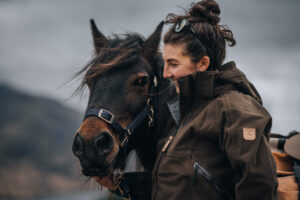Multi-day self-supported wilderness expeditions are some of the most immersive and bonding experiences on Earth, but what does that adventure look like when you introduce a pack animal into the equation?
Eliza Brown recently walked the length of the Scottish Highlands with a pack pony. First appearing in issue 08 of BASE, here she provides an introduction to pony trekking, recounting some of her experiences from taking on the Cape Wrath trail and offering a practical guide to undertaking an expedition like this yourself.
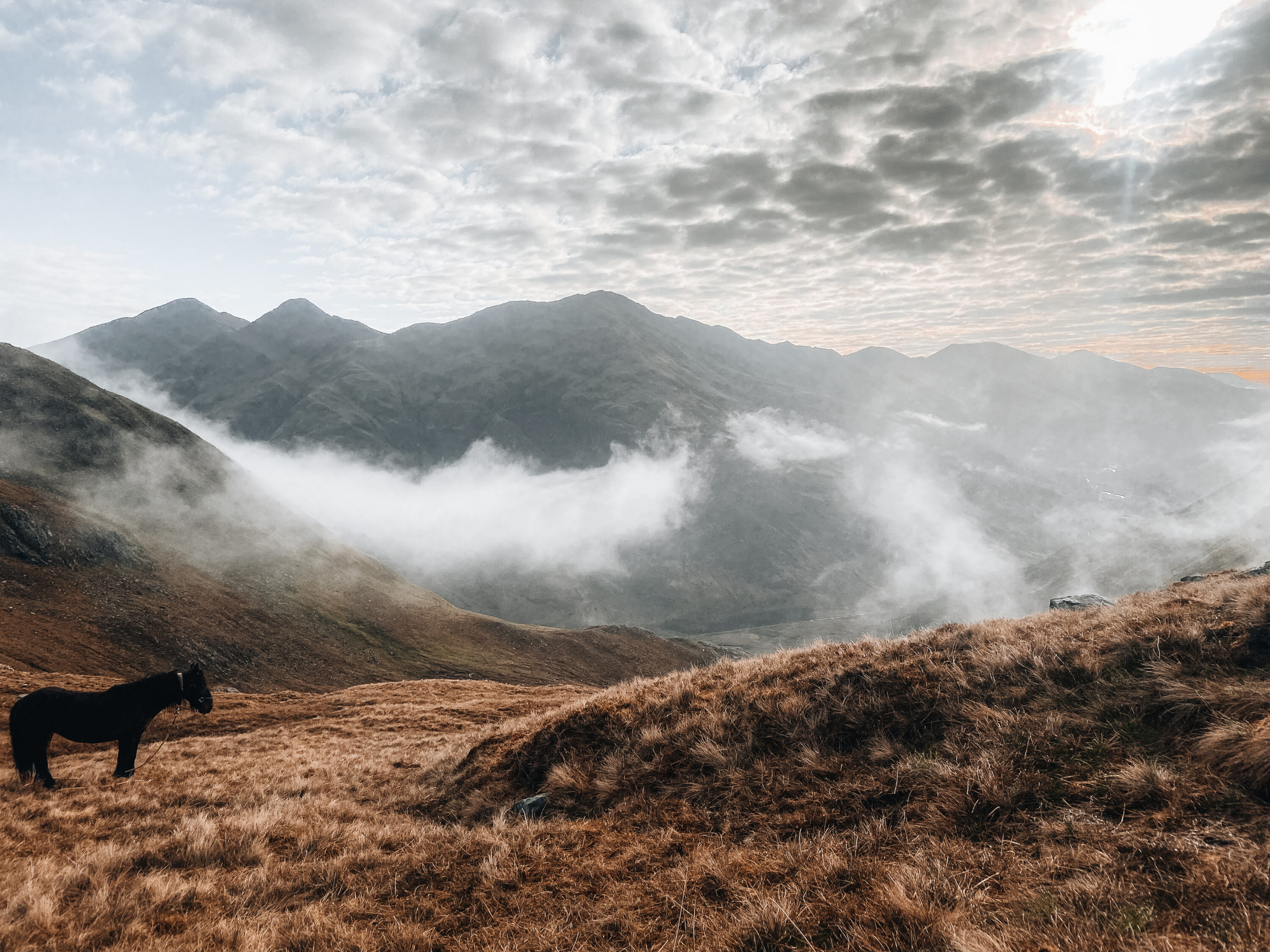
My four-legged companion had a wild and unkempt look. Hades Hill Pansy is a dark bay fell pony with a long and matted main, her wispy ears always seem to point the way. She is full of heart and personality.
Against the untamed backdrop of the Scottish Highlands, she was at home, a picture of pure contentment. Together, in the spring of 2022, we navigated our way over what is known to be Britain’s most wild, remote and challenging terrain. Away from the comforts and luxuries of modern day life, just me, a pony and the remote Scottish wilderness.
Working with pack ponies all began when I stumbled across Fell Pony Adventures whilst browsing the travel section in the paper over breakfast one morning. I learnt to ride horses before I could walk and saw this article as a potential opportunity to combine my love for horses with my work as an expedition guide. In 2019, I started working with Tom, the owner of the Hades Hill herd of fell ponies and the founder of Fell Pony Adventures. As a qualified Mountain Leader and Wilderness Guide, my job was to take clients on the wild camping pack pony treks to hidden corners of the Lake District.
On the first expedition I led, we took a team of five fell ponies over to High Street. The weather was horrendous. As a team we faced strong winds, snow and torrential rain. But despite the cold, wet and general misery, these ponies didn’t bat an eyelid, they weren’t phased by a thing. And the clients were so distracted by their trusty companions, that the extreme weather couldn’t sap their spirits either.
I knew from that experience this wholesome way of travel completely suited my personal ethos as an outdoors lover. I was completely overwhelmed by how travelling with pack ponies instilled self-confidence in people.
The reason why the ponies leave such a profound impression on us, I suspect, has something to do with the fact that we, as a species, have worked with horses since the very beginning of our existence. They are ingrained into our human psyche. As I continued to work with Tom and his herd, it didn’t take long for the lightbulb in my head to spark and I was soon planning my own big adventure with a pack pony. My grand idea: to walk the length of the Scottish Highlands.
No matter the location or the distance one intends to travel, when exploring with a pack pony, every day is a rite of passage. There are unexpected challenges around every corner – you constantly have to think: four legs! Obstacles such as fences and cattle grids, which are not always marked on the map, will force you to alter your intended route. Despite this, tackling and overcoming these hurdles is all part of the fun and the unique nature of travelling with a pack pony.
The experience teaches you to problem solve, to think on your feet and to adapt to changes in your route. It is these vital practical skills that the comforts and luxuries of modern life inhibit us from exercising. I have witnessed first hand how travelling with pack ponies can help to equip individuals with practical tools and skills that improve confidence, resilience and the ability to adapt, survive and thrive in nature.
I remember one particular occasion, when my survival instincts were put to the test. Pansy and I were walking from Kinloch Horn to Sheil Bridge over the Falcon Ridge in the Scottish Highlands. Miles from civilisation, it felt extremely remote. We had survived the torrential rain that fell the day before, but that mass of water was now flooding the mountain rivers. I encouraged Pansy across the fast-flowing, powerful water. Navigating to the other side of rivers like this was just one of the many trust-tests we faced on our long journey. I remember feeling a little nervous about what lay ahead. The navigation was challenging but we gradually worked our way up to the saddle that sat just below the Forcan Ridge.
After summiting the ridge, the descent I had hoped to take was lined with giant boulders, making it impossible for a pony to pass. Those boulders weren’t visible on any map. Apparently they’d been placed here by estate owners centuries ago, to restrict peasants from crossing territories. There was a hiking trail, which I had hoped we would have been able to follow down the mountainside to the safety of Sheil Bridge, but there was no way I could get a pony across these giant lumps of rock. It was a route that was going to be challenging with two legs, let alone four!
It was getting late, we were both tired and the weather was deteriorating, and I felt the pressure to make a decision. We could turn back, perhaps add another 24 hours onto our journey or, we could weave our way down the very uninviting bowl of the steep glaciated valley below that might just allow us to bypass the boulder section. It looked disgustingly boggy.
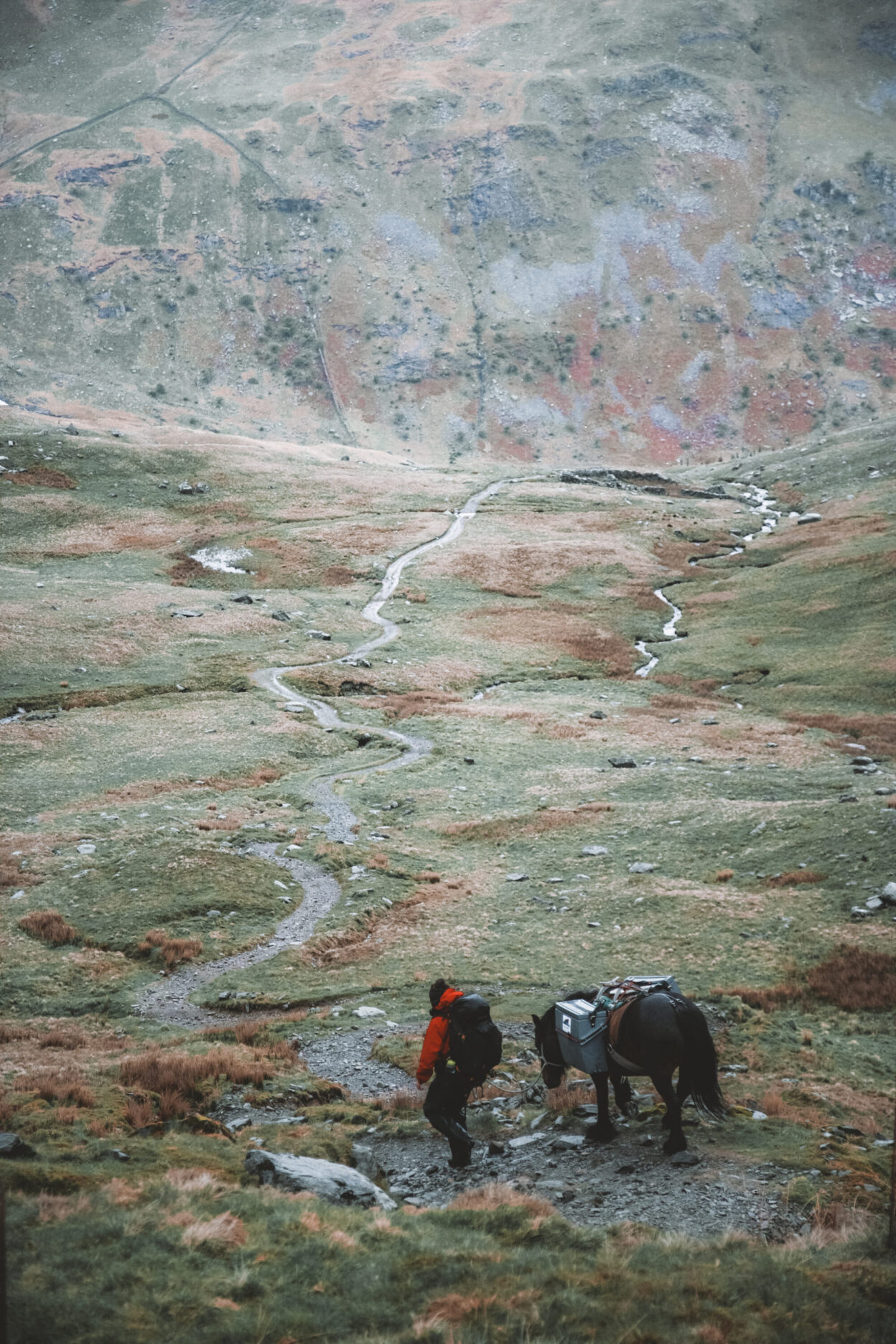
She was the master of this landscape and I, a mere student
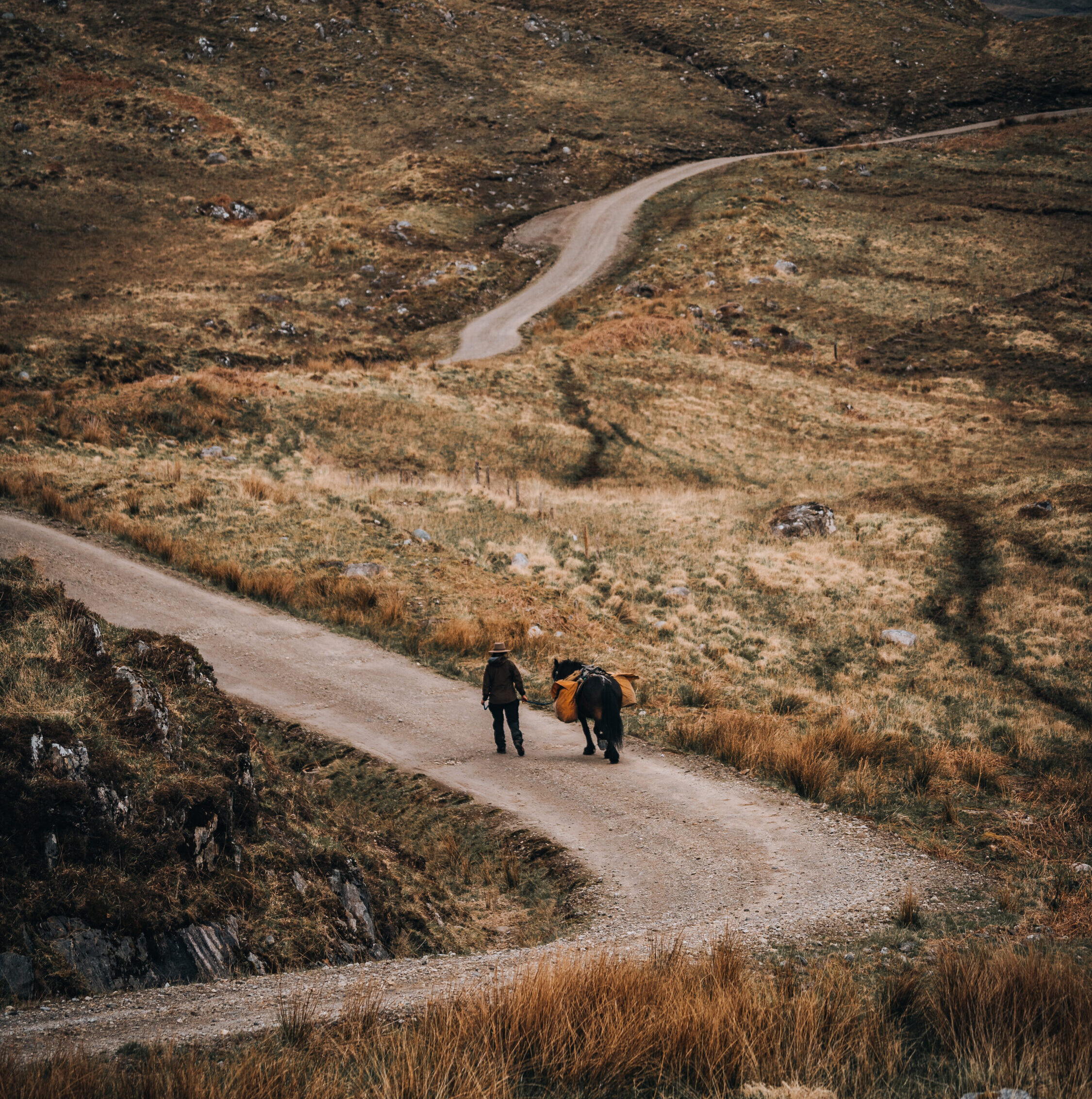
Scottish Highlands at the beginning of a very long journey. © Grace TSP
The gentle pace has allowed me to notice nature’s more intricate details, its colours, shapes, smells and sounds
After exchanging a look of uncertainty with one another, Pansy broke into a walk and started to make her way down into the valley, as if to say, come on Eliza… follow me down, we’ll be fine!
That was the moment I really had to learn to trust that pony. She was far more experienced than I at reading the soft ground. With the occasional slip and slide, and the odd stop and change in direction, we made it to a contour where we then hand-railed to rejoin the other end of the footpath, the one that I had originally intended to descend. We were back on course! Phew!
By now, we were both exhausted and it had just started to rain. The ground was still extremely sodden from the wet weather of the previous day, but there was no running river, just trickling puddles. With very limited grass and no flat ground in sight, this was far from an ideal place to set camp for the night, but I knew we needed rest. We just had to make do with where we were. I removed the load from Pansy’s back, hammered her tether into the soft ground, filled her folding bucket with water from the nearest peaty puddle, tipped out some emergency pony nuts on the ground and pitched my tent on the flattest ground I could find.
I laid out my sleeping bag and boiled water for my dehydrated meal and peered out of my tent door. Wow! The rain had stopped and the clouds had lifted. Pansy was standing, her back leg resting, also admiring the view. After a challenging day, this was our reward. It was all worth it for that glorious panoramic of the valley below us. We were safe, dry and fed and would be ready to tackle the rest of the big descent the following morning after a good night of sleep.
This style of travel has taught me how to be more prepared to adapt both mentally and physically. With a pony, you can’t plan too far ahead. But that’s the beauty of this style of travel. With every hurdle and challenge you face together, the closer you become as a unit and begin to move as one.
I grew up racing horses, but nothing can compare to the bond I built from walking alongside a pony, for the 19 days I spent walking The Highlands, at her eye level. It was a whole different experience. I learnt to understand her, read and predict her movements. Pansy would always seem to make the right decisions, especially when reading the boggy ground. She was the master of this landscape and I, a mere student.
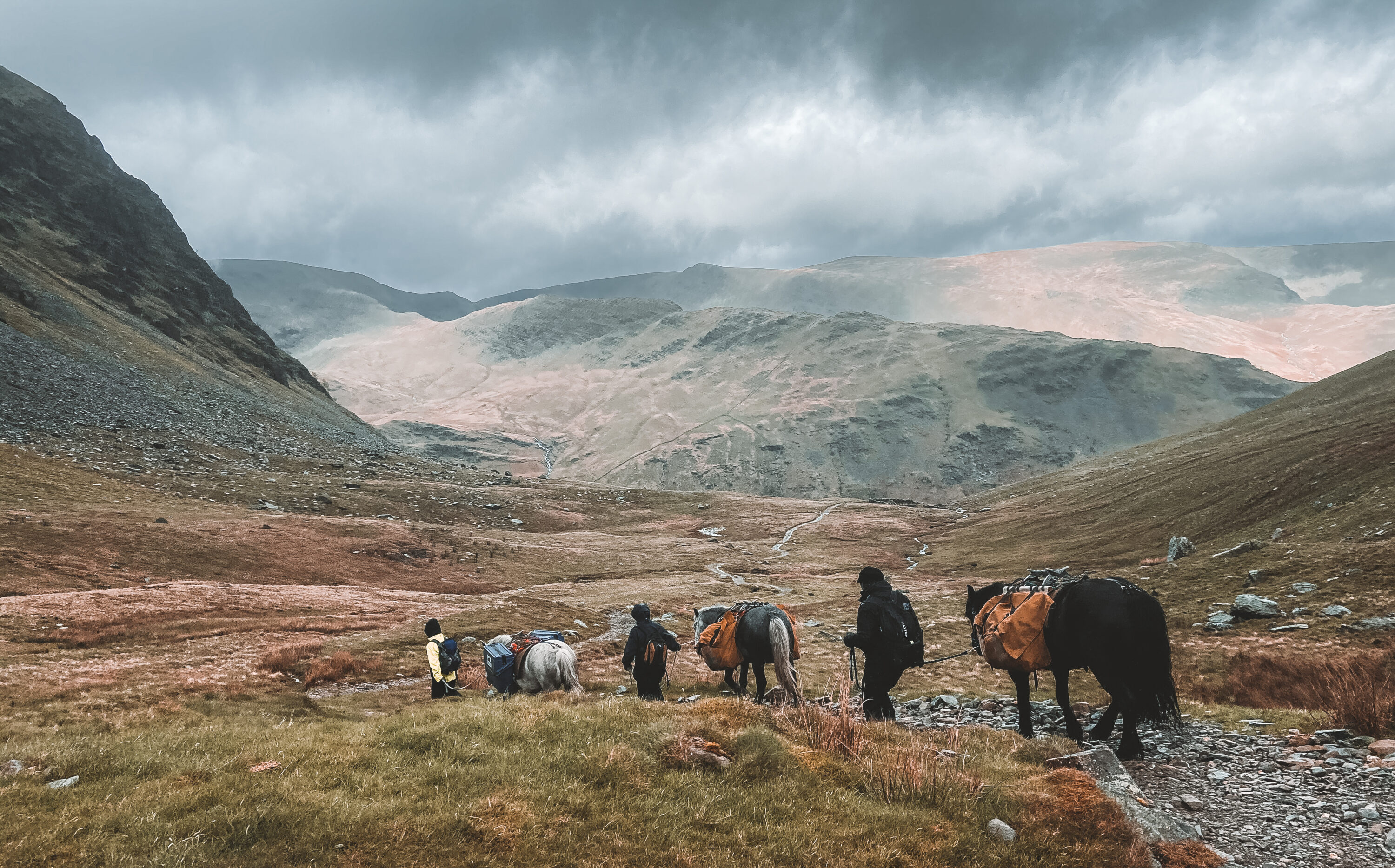
Travelling with a pack pony forces you slow down, not something I personally have ever found easy. I learnt that all I ever need to do is follow the pony, move at its pace, with no rush, no stress, no deadlines, nothing but the here-and-now, focusing on the pony and the adventure together.
Once I could adopt that rhythm, despite the slow and steady pace, it was astonishing the distances we could rack up – just tackling the day one step at a time. From my experience, the gentle pace has allowed me to notice nature’s more intricate details, its colours, shapes, smells and sounds. I always seem to absorb the entire experience more holistically. I remember minute details of each day. Something I have never truly observed to this extent on any other expedition.
Of course, the greatest benefit of travelling with a four legged companion, is that they can carry the heavy load – as much as 50kg. A rather fancy feature, a luxury, especially when you have, for example, 400km of walking ahead of you, over unforgiving terrain.
This is, after all, what this species is built for. Cumbrian fell ponies were bred as pack ponies for carrying slate and charcoal along the old drover tracks before the railways and roads were built. They are now an endangered breed, with just 200 breeding mares left out in the fells, and many semi-feral herds and important blood lines have been lost. To maintain a gene pool of hardy fell ponies, for them to thrive, they need to keep doing the job that they’ve done for centuries. Carrying the heavy load. Where better to put them to work and support a dying breed than on an expedition?
This story first appeared in issue 08 of BASE, you can subscribe here to get every issue direct to your door.
Don’t miss a single adventure
Sign up to our free newsletter and get a weekly BASE hit to your inbox
You might also like
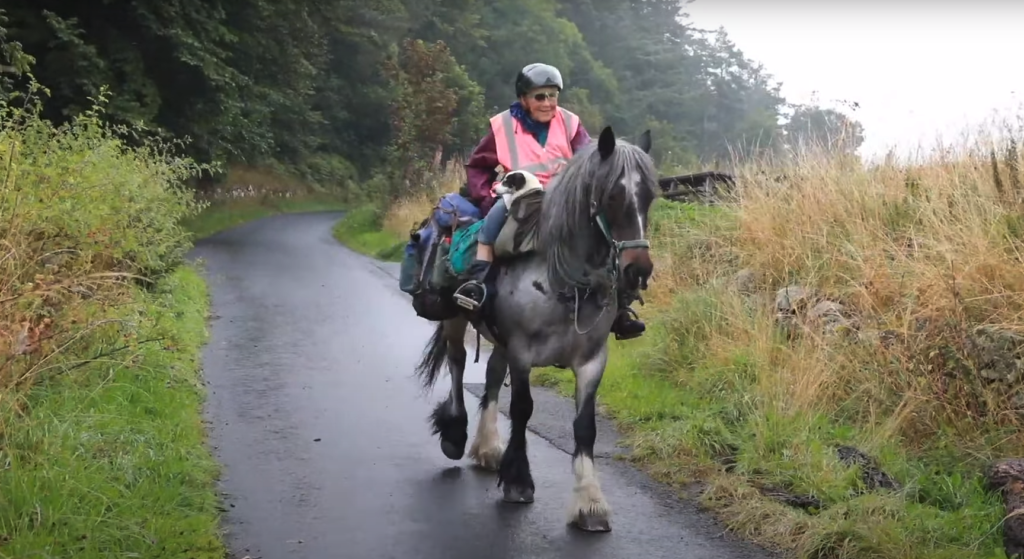
Video • BASE editorial team • Sep 10, 2021
This 80-Year-Old Woman Rides A 600 Mile Horseback Adventure Every Year
Every year since 1971, Jane Dotchin packeds up her saddlebags for a 7 week adventure on horseback.
